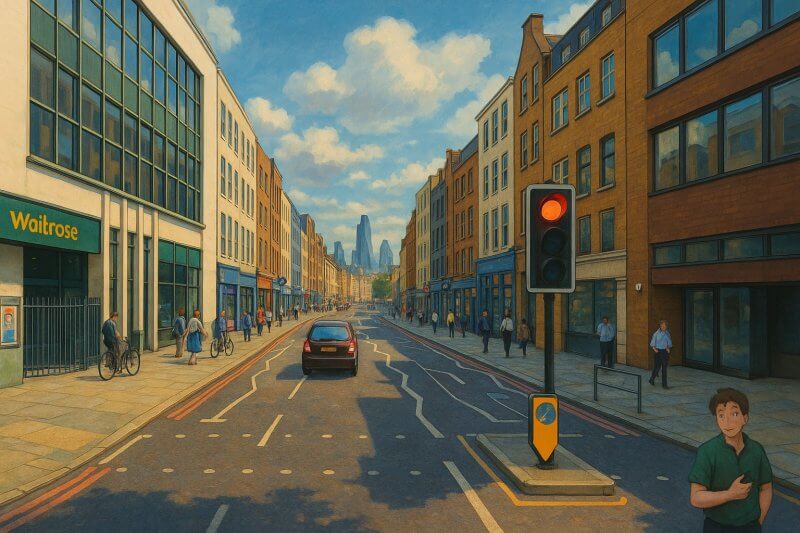
Borough High Street, London
Where is Borough High Street?
Borough High Street is located in the London Borough of Southwark, just south of the River Thames. It runs through the heart of historic Southwark, forming a key thoroughfare linking London Bridge to the south London suburbs.It is considered the southern continuation of London Bridge, starting just as the bridge ends and extending into the heart of Borough, making it an important artery for both pedestrians and vehicular traffic.
How Long is Borough High Street?
Borough High Street stretches for approximately 0.5 miles (0.8 kilometres). While relatively short in length, it plays a major role in London's traffic flow and urban heritage, acting as a central point in Southwark’s road network and a historic gateway into the city.History of Borough High Street
The origins of Borough High Street can be traced back to Roman Londinium. It was once part of the Roman road known as Stane Street, which connected Londinium to Chichester on the south coast. This made it one of the earliest and most significant routes into the city from the south.During the medieval period, it developed into a bustling commercial route, especially because London Bridge was the only bridge over the Thames at the time. The street became lined with coaching inns, shops, and homes, serving as the main route for travellers entering the city from the south.
In the 18th and 19th centuries, Borough High Street saw major developments, including the construction of Southwark Cathedral’s current building and the expansion of nearby railway infrastructure. It remains a historic and vital London street to this day.
How Did It Get Its Name?
The name “Borough High Street” reflects both its geographical and administrative significance. The word “Borough” refers to the old Borough of Southwark, historically known as “The Borough”, which for many centuries was administratively separate from the City of London despite being just across the river.The term “High Street” denotes its status as the main commercial road in the area. The street has been known as Borough High Street since at least the 17th century, when street naming became more formalised.
So, it is named after the place it runs through—Southwark, also known historically as The Borough—and not after an individual.
Roads Connected to Borough High Street
Borough High Street is a key junction in south London and connects to numerous roads. These include:- London Bridge (to the north)
- Southwark Street
- Union Street
- Marshalsea Road
- Borough Road
- Great Dover Street
- Long Lane
- Trinity Street
- Newcomen Street
- Tabard Street
Major Buildings on the East and West Sides
East Side:- Southwark Cathedral – One of London’s oldest churches, located near the northern end close to London Bridge.
- The Borough Market – A world-renowned food market, just a short turn off from the street.
- Guy's Hospital – A major NHS hospital with a medical school, also located near London Bridge station.
- The George Inn – A historic coaching inn dating from the 17th century, now owned by the National Trust and operating as a pub.
- St George the Martyr Church – An 18th-century church at the southern end of the street.
- Borough Underground Station – Located near the southern end, offering vital transport connections.
Nearest London Underground Stations
Borough High Street is well-served by public transport. The nearest Underground stations are:- London Bridge Station – Served by the Jubilee and Northern lines (Bank branch). Also serves mainline rail.
- Borough Station – Served by the Northern line (Bank branch). Located at the southern end of the street.
- Southwark Station – About a 10-minute walk west of Borough High Street, served by the Jubilee line.
Fun Facts about Borough High Street
- Borough High Street is home to The George Inn, the only surviving galleried coaching inn in London. It was visited by none other than Charles Dickens, who mentioned it in Little Dorrit.
- The street was a major pilgrimage route in medieval times. Pilgrims heading to Canterbury would often depart from the Tabard Inn, once located on Borough High Street. This inn was famously featured in Chaucer’s *Canterbury Tales*.
- The area around Borough High Street has seen a cultural revival in recent years, becoming a foodie destination thanks to Borough Market and the many restaurants and eateries that line the street and its side alleys.
- There’s a blue plaque marking the former site of the Marshalsea Prison, made famous by Dickens in *Little Dorrit*. Dickens’ father was imprisoned there, and the author himself lived nearby as a child.
A Living Link Between Past and Present
Borough High Street is far more than just a road—it’s a vital historical artery of London, weaving together Roman heritage, medieval commerce, literary history, and modern vibrancy.Whether you’re walking the route of ancient pilgrims, enjoying a drink at a historic inn, or heading to the market for lunch, you’ll find that Borough High Street offers a rich, multi-layered experience for locals and visitors alike.
Map of Borough High Street, London

Painting of Borough High Street (View full-size image here)